Google developed an artificial neural network to interpret imagery. At first I was modestly intrigued, but now I’m starting to see the threat it poses. Essentially, it’s a filtering process that starts with easy stuff like detecting edges, then shapes, and moving on to identifying what is being seen. The neural networks are honed by exposing them to volumes of images, such as of animals, trees, or buildings, so that they are better able to search for the common features of those subjects. The aim was for a computer to look at an image and be able to say something like, “That’s a golden retriever”, or “That’s John Connor…”.
That is already interesting, but the Google team discovered that the process could be reversed so the neural networks would generate images of animals, trees, and so on, by asking them to enhance the features they were looking for. The result is something like seeing images in clouds or while tripping balls on acid. The computer sees things that aren’t there, and renders them.

The neural network can even repeat the process on it’s own rendered images, in a sort of feedback loop, so that it refines the dogs, or whatever, that it has created itself from anything that remotely resembled a dog. And on and on.
What we get are very psychedelic images, and some of the more hi-rez images produced are not just weird, but beautiful. People everywhere were asking where they could get prints, and now you can even upload your own images and get them filtered through the algorithm here. Below is a gallery of some of the better examples I’ve found so far [Also included at the bottom of the post so you can click on them for the full-sized versions]..
So, what’s kinda’ scary about this? The Chess computer Deep Blue defeated the world Chess champion Gary Kasparov, for starters. And this pretty much killed the game for me. Imagination and creativity aren’t an asset in Chess anymore. Sheer, brute, calculating power is the unassailable winner. But that would never apply to art, or so I thought. A computer isn’t alive, isn’t conscious, doesn’t have an interiority, no feelings, no fears, no love, no anger. A computer doesn’t give a shit. How could it make art or write a novel without any passion or compassion?
[While you’re here, take a look at some of my human-based art. Scroll deep and expand your visual horizons.]
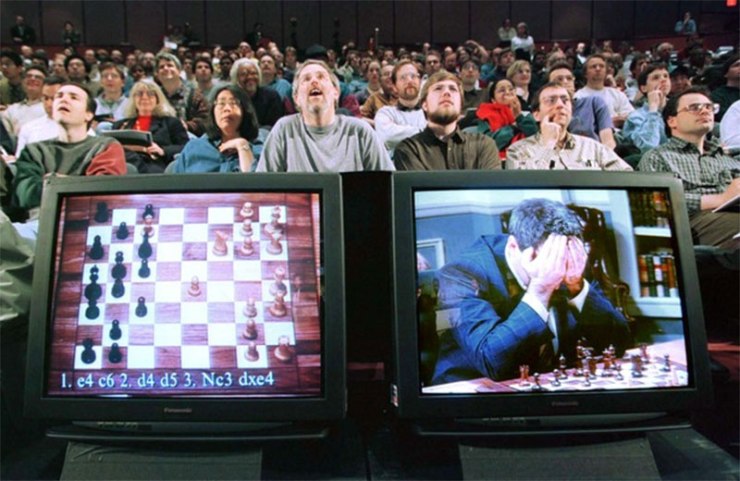
I still think I am right about that, but the danger is that a computer could fake it. And if it could do a pretty good job of it, one might need to be a genuine connoisseur to tell the fake art from the real thing.
What if instead of being trained to recognize dogs, or buildings, a neural network were fed super hi-rez images of the mature style paintings of Monet, Van Gogh, or Picasso? Let’s just use Monet landscapes. Let’s say the algorithm is refined to identify Monet paintings, and even fine tune it by teaching it to differentiate them from landscapes by Pissarro, Renoir (he did some), and other of his contemporaries. It might start making some good facsimiles. To kick it up further it needs to be fed up-close details, and know that’s what they are, so that it can search for and thus generate characteristics of Monet’s brush strokes. We could then look at where the computer falls short, and tweak out the algorithm. It could be combined with neural networks that are developed to recognize all the kinds of subject matter in Monet paintings. After the computer has analyzed hundreds of Monet paintings, and thousands of haystacks and sunsets, it might learn to compete with the artist at his own game. It might be possible to go on to mix and match artists to get the neural network to develop a new, hybrid style. And what if this algorithm could be combined with the one that is designed to detect creativity in visual art?
Oh no. I just thought of something. If instead of dogs and eyes and whatnot that the algorithm was refined to decipher, and thus could be reversed to create, what if images of sexy women were used? Or porn? I’m sure the results would be sometimes horrific, and sometimes titillating, and often combinations thereof. If an artificial neural network can create dogs out of nowhere, it can create boobs, and thus reach a massive audience. I’m half joking, but I can’t be the first one to have thought of this. There was already the strange effect where an algorithm was tasked with generating dumbbells, but incidentally created arms to go with them (because it’s view of dumbbells was based on images, many of which included arms).
I’d want to feed the program images of aliens, then have it go looking for them and inventing them. The possibilities could be fascinating. I’d actually love to work with the people that developed the algorithm to explore the more creative possibilities for realizing unprecedented imagery. The artificial neural networks will think of possibilities that we humans would not, and perhaps could not.
Even without any specific attempts to rig the neural networks to deliberately make fine art images, the accidental oddities created by Google Deep Dream are already getting more attention than the visual art of any contemporary artist. It unwittingly created its own style, which has captured the imaginations of viewers around the world. Using big data a computer could generate thousands of possible styles. The challenge may already be not to keep ahead of the computer, but to fight it for the attention of the eyes of humanity.
I maintain that only a conscious, feeling thing that knows it is alive and has a choice whether to even make art or not, and cares about anything at all, can produce truly substantive work. The proof, however, will be in the images.
Some will argue that the computer images are soulless, but the initial images generated were not intended as art or to express feeling. One could create an algorithm for recognizing and then creating Expressionist paintings. With enough work, the results could get scary. Another argument is that the real artists are the programmers, and the algorithm is just a tool. That works a bit for me, because I don’t use fractal programs because I don’t feel I can fully take credit for what they produce, as they do 100% of the rendering (which would be the hardest part if one were to try to make similar images through traditional, physical means). However, we wouldn’t say that the programmers of Deep Blue beat Garry Kasparov at Chess. They couldn’t. It’s the program that beat him. And in the same way, the programmers can’t foresee what the imaging algorithm will produce, nor are they capable of doing it themselves. And the images are produced by artificial intelligence, so it’s tough to not give those neural networks any credit.
[Click on the images below to see them sized for your screen in a new tab].

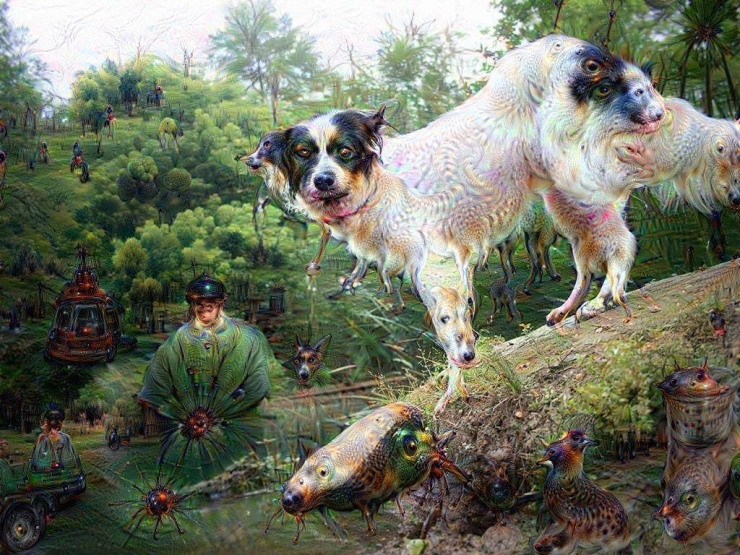


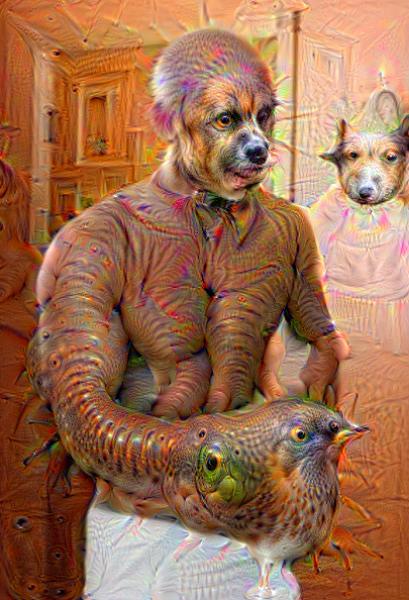
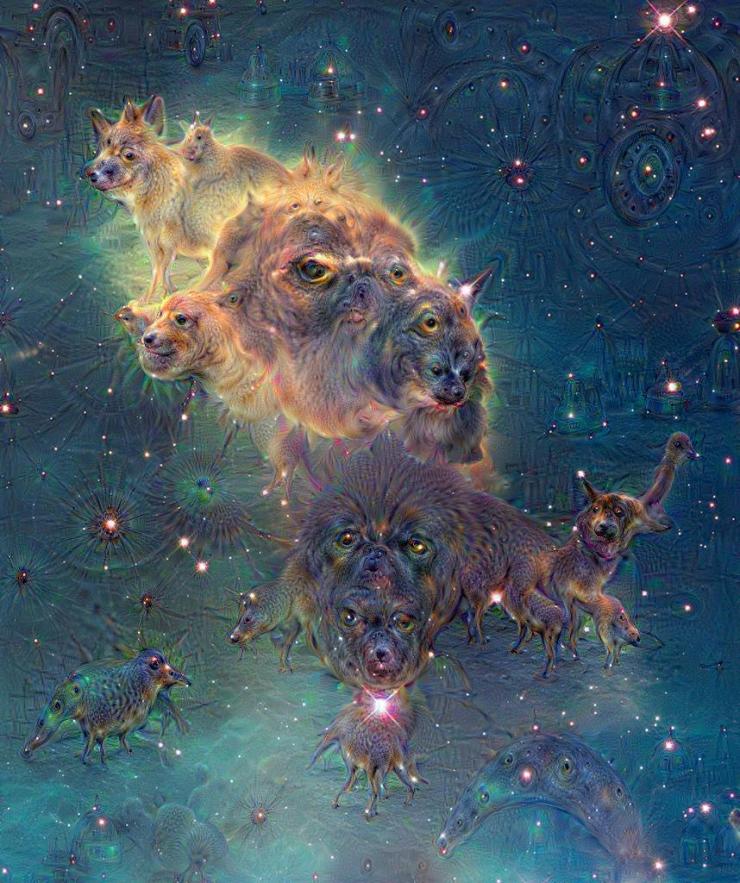
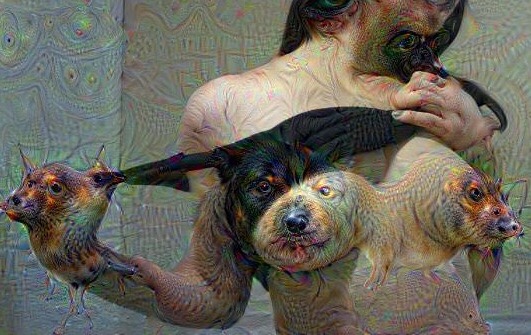



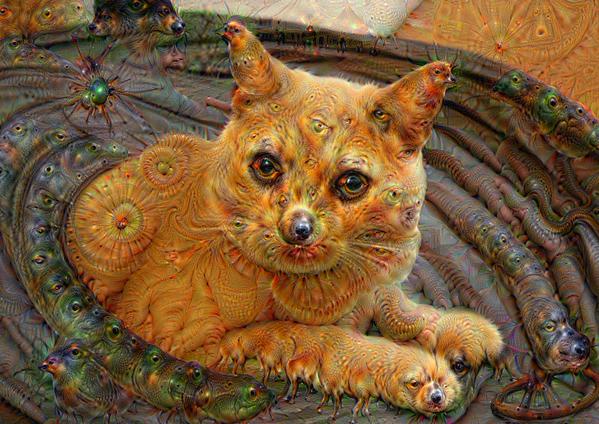

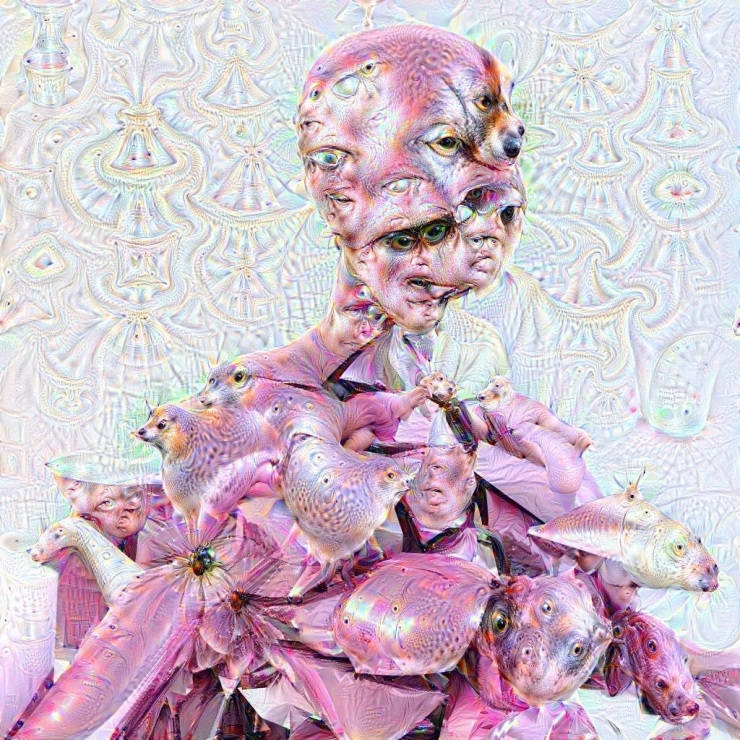

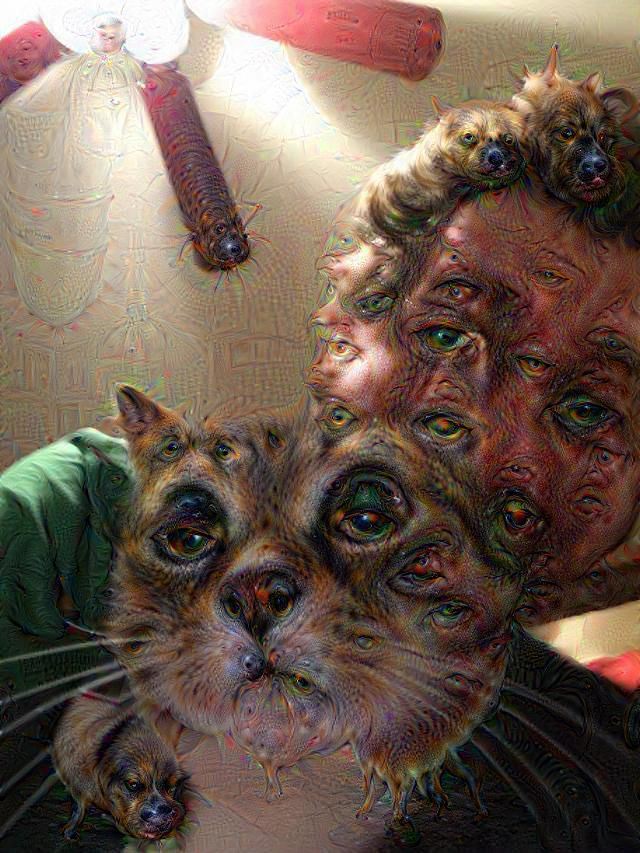


People may want to dismiss these automatically, rhetorically, as something like the byproducts of a clueless or malfunctioning computer program, but I’m grateful for them, even if they make it even harder in some ways to be a visual artist (especially if you use digital media).
I like the image of the galaxy and the one of the squirrels enough that I’d hang posters of them on my walls. The process can look like a gimmick or technique, but that’s not what’s really going on. What we have here is the beginnings of the ability to peer into the mind of AI, which is an alien intelligence that doesn’t function by our rules or within the parameters of our anatomical orientation to the universe. This voyaging into the mental process of the computer is very evident in video when we zoom in and it keeps manufacturing new imagery on the fly.
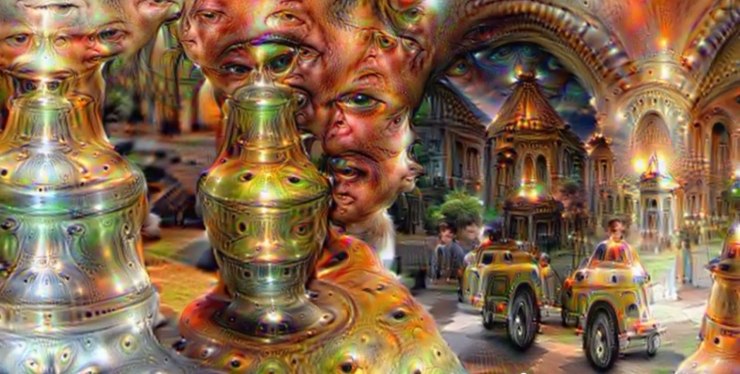
Here is a video from which I took the still image above.
I think we can learn from how a computer sees the universe, and even broaden our visual horizons. What’s more, there are definitely passages in the images that are beautiful, in a very psychedelic way. And this is just the beginning.
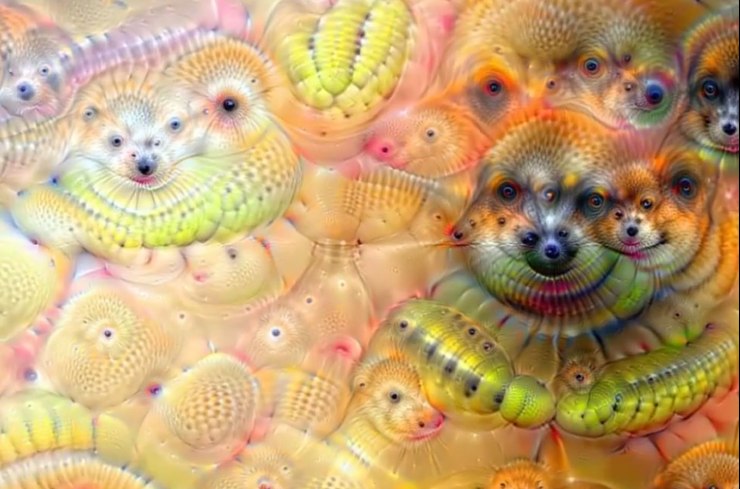
~ Ends
Addendum:
And if you are STILL not intimidated by the power of these neural networks, you may not know that the details appear to be infinite. You can just keep zooming in, and in, and in! There’s no way a human visual artist can compete with that using analog methods.
You can view these examples:
It can even be used in real time on video. See below for a brief presentation on how it works (the weirdest stuff is at the end).
Lastly, these images cropped up at a time when I’m making my own art about artificial intelligence, robots, and humans. Check out the piece I just finished, in which conscious robots are being destroyed because of the threat they pose to humans. Is it saving our species, or genocide.

Below is a close up of the image above, so you can see the painterly brush work I use. You can see many more details, and learn about my process and the meaning of the piece here.
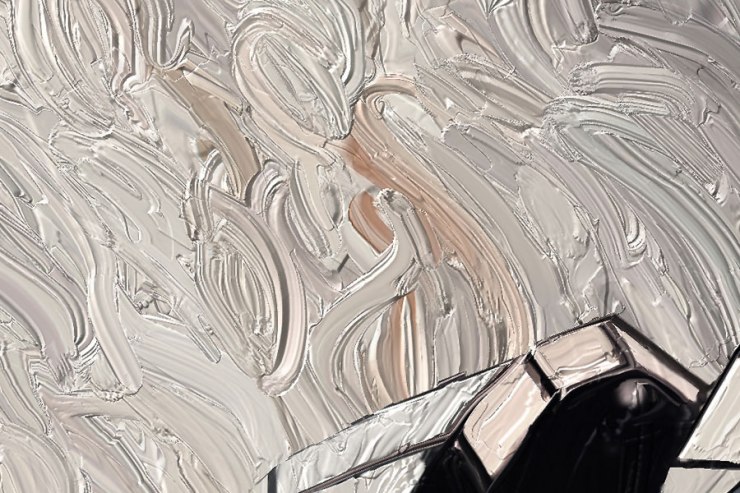
And in the piece I am currently working on, a robot is shooting a human. It’s more complex than that, but here it is so far.

To see how the rest of my art (which combines digital and traditional approaches) compares to Google Deep Dream, go here.
Also you might be interested in the algorithm that is being used to detect creativity in visual art, which I wrote about here.
~ Fini!

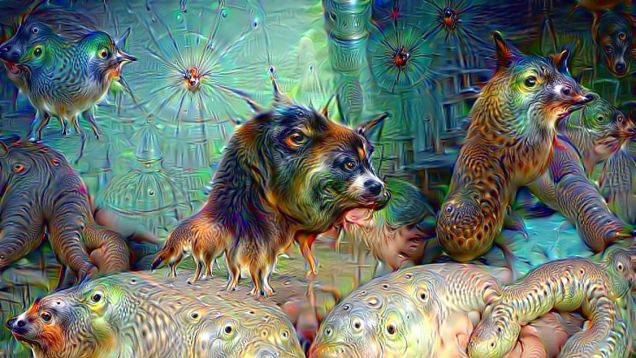



















It’s a new territory… and a bit scary, maybe.
Good post and very interesting thoughts.
LikeLiked by 2 people
Looks like it’s going to be a gimmick that’ll bore us the more it gets used. How many uncovered stills from the set of The Thing do we need? The thing to see in the shorter term is whether it’ll put illustrators out of work or draw on their visual skills and give them work?
LikeLiked by 1 person
I think this particular algorithm will get boring, as you say, once we get used to eyes and dog’s heads popping up everywhere. But the range of possible algorithms that can be deliberately created and combined for generating new imagery is enormous. For example, in another article I wrote about the algorithm for detecting creativity in visual art. It if could be used to instead generate a semblance of creativity, it could generate oodles of samples. There just doesn’t seem to be any limit to what can be achieved by tinkering with, and combining algorithms. It may be that artists will use artificial neural networks as a way to get ideas or inspiration for pieces they elaborate on.
LikeLiked by 1 person
AI is a tool. It has no idea what it’s doing. Interestingly, a lot of artists claim similarly – Francis Bacon, for example said that chance takes over, and what he called ‘accident’. We could say that he had a methodology for applying paint, one that allowed him to step back and let something other than himself take over. Is that art normally relies on analog algorithms?
LikeLiked by 1 person
Of course the algorithm has no idea what it’s doing. It’s not conscious. But that doesn’t mean it can’t inadvertently create something novel. The fact that it doesn’t create inline with a human sensibility opens it up for rendering imagery we’d never come up with, and aren’t capable of producing. It just occurred to me a few minutes ago what would happen if instead of keying the algorithm to identify/render things like dogs, the object were, say, nudes. There are so many possibilities, including artists using the computer as a tool to suggest directions to take their own work, or collaborating with it.
Bacon used chance when he flung paint, and a lot of his brush and rag work was chancy, but all of that was within an approach that was extremely self-aware and even calculated. In his later years he became a bit of a parody of himself, using some of his standard techniques as a gimmick.
Personally, I agree that the computer has no feeling, intend, imagination, or even knowledge of what it is doing. but we must still look at the results, I think, without judging them AS having been created by a computer, but as images which are intrinsically good or not. Obviously I prefer the think the computer can’t compete with me. The mass popularity of its images, as compared to mine may prove otherwise.
LikeLiked by 1 person
> Obviously I prefer the think the computer can’t compete with me. The mass popularity of its images, as compared to mine may prove otherwise.
Yes, the narrative going on in this is whether or not this is another example of humans being displaced by a machine that can offer something that more people want. I really appreciate secondhand bookshops, but most people download e-books and in doing so, have a knock-on effect.
But the Google images invent rather than merely deliver something already extant in a cheaper (if very different) way. I think they’re interesting to look at, yet it won;t take long for me to get bored. It’s hard to imagine much variety coming up soon. No matter who uses this code, the results are surely going to be similar?
LikeLiked by 1 person
I prefer to think you are right, but if you change and recombine the codes, the possibilities may be endless.
LikeLiked by 1 person
“It’s hard to imagine much variety coming up soon.”
For me it’s hard to imagine immense variety NOT coming up soon. The stuff is open-source and dozens of capable kids are tricking the hell out of these neural networks and algorithms as we speak. What we’ve seen so far are a handful of trivial presets found in the first week, but the algorithm itself offers a virtually unlimited number of parameters and you bet there’s plenty of unspeakably cool stuff hidden in there.
Just look at these things that popped up in my feed today and say they are “uncovered stills from the set of The Thing”:


LikeLiked by 1 person
Agreed. This can revolutionize digital imaging, and imaging in general.
LikeLike
cool blog thank you
LikeLiked by 1 person
Yup
LikeLike
Its going to create a massive blossom of artists who are familiar with computer code, convolutional transformations, deep learning and machine intelligence. However channeling, manifesting and seeding inception is the HARD part.
LikeLiked by 2 people
Reblogged this on Sinéad Meehan and commented:
This is interesting. Very interesting.
LikeLiked by 1 person
I don’t know. So far, I’m finding these images — and the other ones I’ve seen generated by this process — rather. . . boring, even gimmicky. It’s a knee jerk response, of course, and I’m certainly not a specialist in the field. But, for all their variety and seeming innovativeness, there’s something really lacking here in these images. . .
LikeLiked by 1 person
I like the one of the galaxy and the one of the squirrels enough that I’d hang posters of them on my walls. The process can look like a gimmick or technique, but that’s not what’s really going on. What we have here is the beginnings of the ability to peer into the mind of AI, which is an alien intelligence that doesn’t function by our rules or within the parameters of our anatomical orientation to the universe. Yes, some of the ones made via webpages from images people uploaded look cheesy, but that’s largely due to the cheesy images themselves. I think we can learn from how a computer sees the universe, and even broaden our visual horizons. What’s more, there are definitely passages in the images that are beautiful, in a very psychedelic way.
LikeLike
I agree 100% I must follow you on twitter
LikeLike
I gave up on Twitter. I got no responses and couldn’t gain any followers.
LikeLike
Oh, Greg Sadler, I subscribe to your channel on YouTube. I listened to a lot of the Existentialism videos while making art!
LikeLiked by 1 person
You seem to be caught up in the populist myth of “the artist/master as a cult of genius”. Where the greatest artist has some kind of sui-generis talent. An unusually, near-freakish capacity of wisdom and emotional intelligence combined with mechanical skill that allows her to depict the essence of something crucial and critical to the human condition. Leonardo Da Vinci or Vincent Van Gogh are each an apotheosis of such myth.
It’s a myth, though, nonetheless. Just as Deep Blue could never have become a chess player without an army of human programmers, so too a computer will render something that may or may not fall into a valuable art object for whatever reason. But it is not assigned “authorship” status as the artifacts it creates are from human-directed ingenuity. The images trained into the ANN are taken by humans. The choices of what images are put into the ANN are made by humans. This is nothing to worry about, unless what your fear stems from maybe having to put your brushes away and turn to a keyboard and digital camera. This is about craft, then, not art.
LikeLike
Don’t be so superficial.
You are making a lot of erroneous assumptions and handing out generous helpings of trivializing insults. I almost don’t know where to start, because your Postmodernist talking points seem unconnected to anything I’ve written. First off, I don’t believe in geniuses. I think art is mostly a question of dedication and persistence. You don’t need to be a genius or have an innate sui-generis (one of a kind) talent in order to say something substantive or genuine about the human condition. I think anyone who is sincere and makes a solid attempt at looking at their world and, let’s say, writing a short story, can communicate something worthwhile from their circumstantially unique vantage. Do you think Van Gogh called himself a genius? My stance on “genius” is very apparent in my criticism of child prodigy artists (https://artofericwayne.com/2014/11/17/is-this-child-art-prodigy-the-real-deal-and-is-she-really-a-threat-to-the-canon-of-abstract-expressionist-painters/).
I’m afraid you’ve fallen into the pseudo-Postmodernist (clap)trap of equating all attempts at doing anything genuine in any of the arts with being a genius, in order to dismiss such attempts out of hand as hopelessly arrogant and preciously self-deluded in favor of the Postmodern or anti-art productions, in which with a mere sleight of hand and recontextualization a mega-genius can render obsolete all the art that went before him or her. A Duchamp, Warhol, or Jeff Koons are the apotheosis of such a myth!
You boldly assert that “the artifacts [Google Deep Dream] creates are from human-directed ingenuity” and hence it is incapable of “authorship”. Well, no shit. It’s not conscious. It doesn’t know it’s making images, be they considered art or not, and it doesn’t even know it exists. Don’t stop there though. Stop and look at the images, and notice they don’t look like anything a human would do, and yet they are highly resolved. Notice, for example, that while the algorithm apparently knows that all limbs and extremities of a creature should be connected, it’s not clear on a limit to how may eyes or legs a creature may have. It often puts them together seamlessly. So what we have is an artificially created process that produces a way of seeing that is alien to humans, and thus fresh to those who have eyes uncircumscribed by ideology to see it with.
You should recognize that when I say Google Deep Dream poses a threat to artists, I am talking about not just it with its peculiar limitations, but future algorithms deliberately tweaked, combined with others, and honed to replicate human art or create images we are not capable of. We are already not capable of producing the images of Deep Dream, without using it to do so, and no, using it to do something is not the same thing as doing it ourselves (in the same way using a crane to lift a boulder is the not the same as lifting it with ones own back).
Surely you recognize that Deep Blue posed a threat to Chess players. But you seem to think it doesn’t pose a threat to human creativity, even as you belittle any such attempts as a myth. You are undoubtedly familiar with the threat the camera posed to art. And here you probably are second guessing yourself for not even having thought of that, when you were suckled on just that conviction when imbibing deep of Postmodernist solipsisms [Read my article on what’s wrong with Postmodernism before assuming I’m ignorant of it: https://artofericwayne.com/2015/02/04/how-postmodernism-has-worked-against-us/]. If a camera can threaten artists, why can’t artificial neural networks which can produce their own imagery? Photography expanded the ways in which we visually interpret our universe, yes? Now when faced with complex neural networks rendering imagery in a way we’ve never seen before, you don’t see it as any threat? The camera was a threat to accurate representation, but the algorithm has – thus far inadvertently – posed a threat to creativity as a uniquely human trait. No, I’m not saying that Deep Dream is creative, but rather that creativity may not be necessary in order to produce novelty.
Many people rejected the novelty of the images created by Deep Dream, usually out of some sort of resistence. But you see that I say that they are novel, and the reason is they are not bound by the limits of human biology and bias, while they are also fueled by a computational power that we don’t possess. We can’t render images that quickly, and if you hadn’t taken time to notice, if you zoom into the images they don’t become just pixels, but evolve into yet other images as the algorithm goes through a feedback loop of building and interpreting on what it’s already produced. You can see that in the videos I embedded.I just found this page with has a video in which the algorithm goes from pure static to create “surrealist” landscapes full of morphs of people, reptiles, and furry animals. If you can’t see the power of it, and if you can’t see how hard it would be for a human artist to rival it, I would tend to think you are just being obstinate [http://gizmodo.com/watch-how-googles-artificial-brain-transforms-images-in-1717058258].The ideological weakness is to deny the threat, and to not appreciate the novelty of the non-human created imagery. Most will just assert they are cold, because, of course, that’s precisely what we’d expect. But, I’m sure we could create algorithms to simulate emotionally charged imagery.
You say there is nothing to worry about, but I’m not sure you get it. Let’s say we build an algorithm to write poetry. It would have every rhyme instantly at its disposal. If we filter enough great poems through it, and train it in a way somewhat similar to Deep Blue – have poets work with it – it might churn out poetry that readers can’t distinguish from that of real poets. It might make some turns of phrase that are compelling. And what if people prefer the poetry of Deep Rhyme to that of humans? As you know, there are already algorithms to produce Postmodern pseudo-philosophical babble.
The threat isn’t the clichéd drivel you were projecting on to me about craft and geniuses, it’s more philosophical than that: can something which is unaware artificially challenge humans at tasks that (unlike Chess) we assumed that you need to be self-aware and feeling in order to accomplish? This pans back to the threat of artificial intelligence in general. It’s a deeper topic than perhaps you first imagined.
On the positive side, I for one recognize the unprecedented imagery produced by Deep Dream as enhancing my visual universe, similar to how photography did for people in the past, and I see possibilities of collaborating with it to produce human-computer hybrid imagery. I’d like to tell you what to do with your “brushes” and “craft” taunt, but I’ll resist.
By the way, I’ve been making digital art for well over a decade, including with a camera and keyboard. Doh!
LikeLike
Google Deep Dream is amazing!!! The possibilities are endless. I have been Deep Dreaming since the project has gone open source. If anyone wants to Deep Dream an image, I can Deep Dream any image for you. https://www.fiverr.com/elhongo/deep-dream-any-image
LikeLike
Damn you turned that into a business fast. It’s a cool idea, but artist like me would want to be able to do it ourselves, tweak it out, etc…
LikeLike
It is an intriguing program. As you say, the future possibilities by tweaking and further experimentation are probably endless. The images you showed all fell into the ick category for me but that was because of the truly disparate combinations used. Such images, computer or human created always have that reaction for me. The porn industry I am sure will make a good use of this.
As someone who creates because there is no other option that involves living and thankfully does not have to rely on it to generate an income I don’t feel threatened by such a program. Whether this kind of image generation will impact the incomes of professional artists remains to be seen but I suspect it will simply because people will buy anything if marketed enough. The truly talented will find ways to use such programs to their advantage. The people who work in such areas that these programs will operate will have to adapt.
LikeLike
Thank you for the interesting post. My partner is Jae Kamel, and he has studied AI for 40 years. He’ll be reading this post by the time you read this comment; it is an interesting project that Google has attempted. IMHO, they are producing boring yet freakish visual works, which have no importance IRL.
Neural networks can be used for helpful and intelligent purposes, rather than producing digital-image abortions.
LikeLike
I certainly can see your position, and partly agree with it. Can something which is unconscious truly make art (without, of course, even knowing it’s doing it). Maybe it can’t, but what it can potentially make is an extraordinary facsimile that will fool many. It’s kind of like the “Turing Test”, except here, if people believe it is real art created by a real person than it qualified as real art. Remember, the makers of Google Dream aren’t even calling its productions art, but I am, some of them, because they succeed by traditional art standards. Some are quite good (though thoroughly unintentional) Surrealist compositions. And if a computer can be trained to recognize and out maneuver masterful Chess moves, maybe it can recognize good compositions, color schemes, use of line, shapes, movement…
Remember that the camera is said to have changed art because of it’s ability to represent external reality accurately. Google Dream creates images out of nothing, and is just the beginning of using AI to create original imagery. The imagery IS original. But at this stage it is unintentional. At the same time there’s another program to recognize novelty in visual art. Can it be tweaked to create novelty? Can it be combined with Google Dream?
Computers can already generate faux Postmodern artist’s statements. They could be used to write poetry that could food people. Why not do the same with art?
Ultimately AI can only simulate the work of a conscious being. It cannot really care, empathize, or understand. It has nothing invested in making art or not. So, hopefully its creations will always be boring, but I think it might fool an awful lot of people, and that’s why it’s a threat to actual artists, such as myself (we already have to compete with millions of amateurs, millionaire celebrity artists, and monumental indifference from people glued to popular commercial media only).
LikeLike
BTW creatvity is not necessary to produce novelty, as you’ve said. However, it is necessary to produce meaningful novelty; and to produce meaning more generally.
LikeLike
If I were feeling defensive, I’d probably agree with you wholeheartedly. However, I’m trying to be open-minded about it. I think we can be fairly sure that consciousness is necessary to register meaning, or certainly to value it (non conscious intelligence doesn’t care about anything because it can’t). I don’t know if it is necessary to produce novelty or meaningful novelty. That would depend on how one defined meaningful novelty. For example, “big data” is being used to not only analyze and test scientific theories, but to come up with them. The real question in any case is can humans use computers as an extension of human will and intelligence to produce meaningful novelty? We already do that if you can accept any fractal image as art.
LikeLike
I don’t see fractal images as Art; but I’m a mathematician, so that would be expected. However, at least one artist I know of, the great David Hockney, does make Art using a computer, using software (and not Adobe). I Recommend David Hockney’s computer art as an example of what a human can do. However, a person would have to have tried using various software to make art with, to really appreciate his work !
LikeLike
I’m familiar with his work, and how he’s used computers, which is a rather natural extension of how he’s used photography. He is not bound by a single technique.
There’s nothing wrong with Photoshop. It’s the basic tool for editing images. You might take a look at my defense of digital art sometime: https://artofericwayne.com/2014/10/10/a-defense-of-digital-painting-and-digital-art-in-general/
Cheers
LikeLike
Excellent post. Here’s another approach to AI art from a few years back : https://web.stanford.edu/group/SHR/4-2/text/cohen.html
LikeLike
I can’t agree with Kurzweil; only humans can make Art. His AI simulates art making; it is imitating humans to do so. Jae and me have had conversations about Ray Kurzweil before, and were not satisfied by his projects, despite his obvious high intelligence. See also http://jonedae.blogspot.com/2015/03/jae-kamels-dictionary-glossary.html?spref=bl and http://jonedae.blogspot.com/2015/07/jku-list-updates.html for an intro to Jae Kamel, my research partner. AI is an area of knowledge for him.
LikeLike
I tend to agree with you, at least as far as to say that AI simulates making art. But how convincing can the simulation be, and can it overtake the real thing in the same way Deep Blue beat Gary Karsparov at Chess (without even knowing it was playing Chess). There are already filters in Photoshop to emulate watercolor, ink drawings, and so on. But I understand your perspective. It’s the same as saying that AI can’t write a novel because it simply has no lived experience, no vulnerability (mortality), no attachment, no compassion, no empathy, no understanding, and most importantly, no consciousness. I think our gut instinct rebels against the notion of something with no feeling making art.
But let me share two ways in which it is already upstaging real art. 1) I’m a member of some artist’s groups on Facebook, and a few people have been posting images cooked by Google Deep Dream WITHOUT crediting the algorithm. What is the response of people who don’t know the images were made by a computer? They “like” them and say they are “wild” and “trippy”. So, it is already fooling people.
2) I’m an artist, and of the tens of thousands of people who have come to my blog to read this particular article, barely a handful have taken any interest in my art at all, even though I’ve made significant work dealing specifically with the subject of AI. Virtually nobody looked at a piece that took me months to produce, uses Blender, Photoshop and Painter, and is about conscious robots: https://artofericwayne.com/2015/06/28/background-close-ups-meaninginterpretation-of-my-new-piece-infinite-objectivity/
What I can see from this is that there is thousands of times more interest in what the computer does than in what I do, even if people are at my blog.
So, we know that Deep Dream can fool people, and it also gets millions of times more exposure than artists who have been working for decades. Therein lies the threat. To get any recognition as an artist is already nearly impossible because of the sheer numbers of people uploading art – Deviantart was getting over 140,000 uploads a day several years ago, for example. If I upload one new image in a month, it’s just one in over 4 million uploads. And how many people even if they do discover something I’ve done will really be able to discern real art produced by a human, that IS original, from something an unconscious algorithm churned out? Precious few.
And some of the images it has produced are beautiful, even if they are entirely accidental, or rather unintentional. They are something a human wouldn’t do, couldn’t do, and as such reveal a novel perspective and literally a novel vision. We may maintain that it has no real message, because it has no subjectivity, no perspective, and nothing to say. However, again, it may be able to fake it so well that only a minority of people will be able to appreciate real art, and most will fall for the billions of mindless computer doodles it churns out.
LikeLike
Dude! Where do you find time to do these indepth articles? I can barely keep up with my day job (37.5 hours a week) and my art work (at least 40 hours a week) and my reading, writing and walkabouts! How do you do it?!!!
LikeLike
I don’t work full time! Which I can do because I live cheaply and I also live in SE Asia. I couldn’t do this if I lived in America.
LikeLiked by 1 person
yo
LikeLiked by 1 person
‘sup?
LikeLike
Beats a pickled sheep in a box any day !!
LikeLiked by 1 person
Took me a few days to get that. Right. You are talking about Hirst. Good one!
LikeLike
I really enjoyed your articles on art. A fresh breeze of honest love for art amongst a lot of pretentiousness or philistinism encountered elsewhere.
I just discovered the “Wombo Dream” app, and it made me think of this article. Take a look: https://www.wombo.art/
It’s impressive.
I still believe that our current generation of AI is incapable of true knowledge, understanding, or creativity. But it’s getting incredibly good at mimicking human creations.
LikeLiked by 1 person